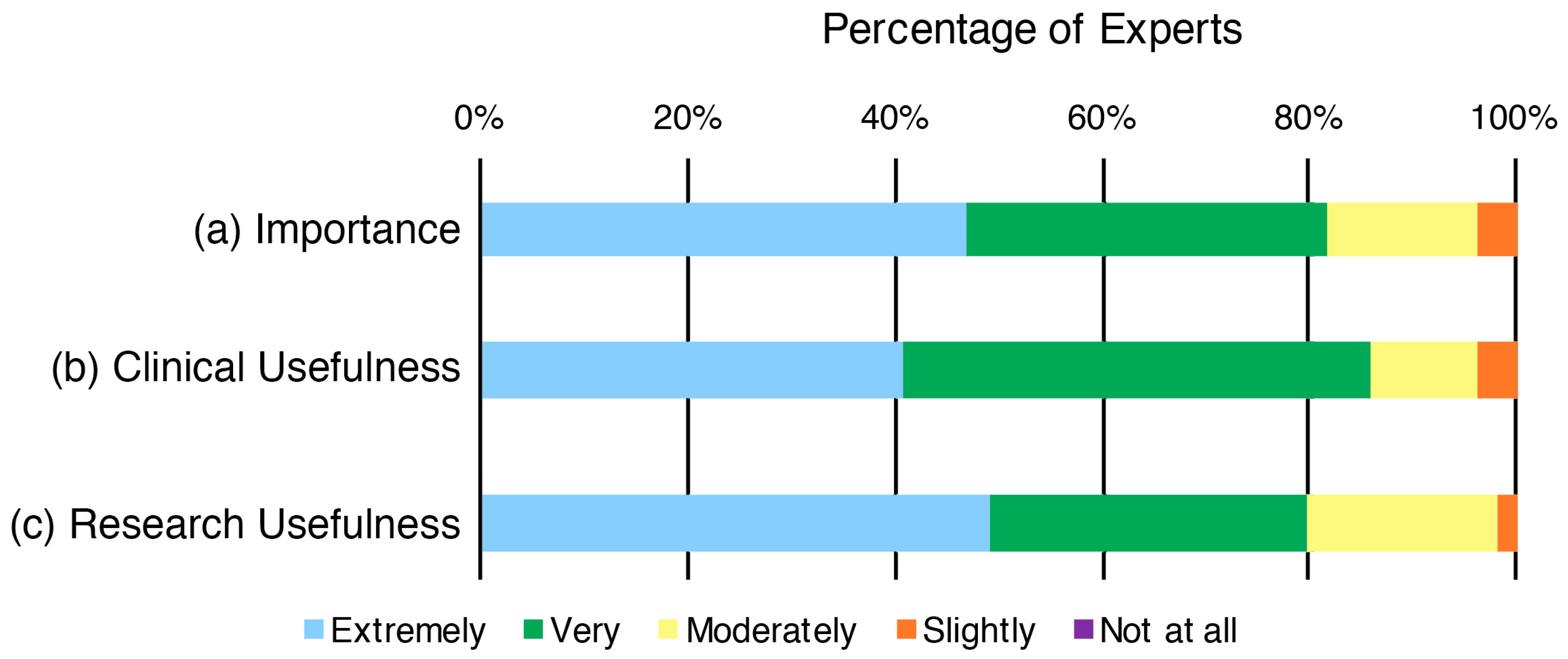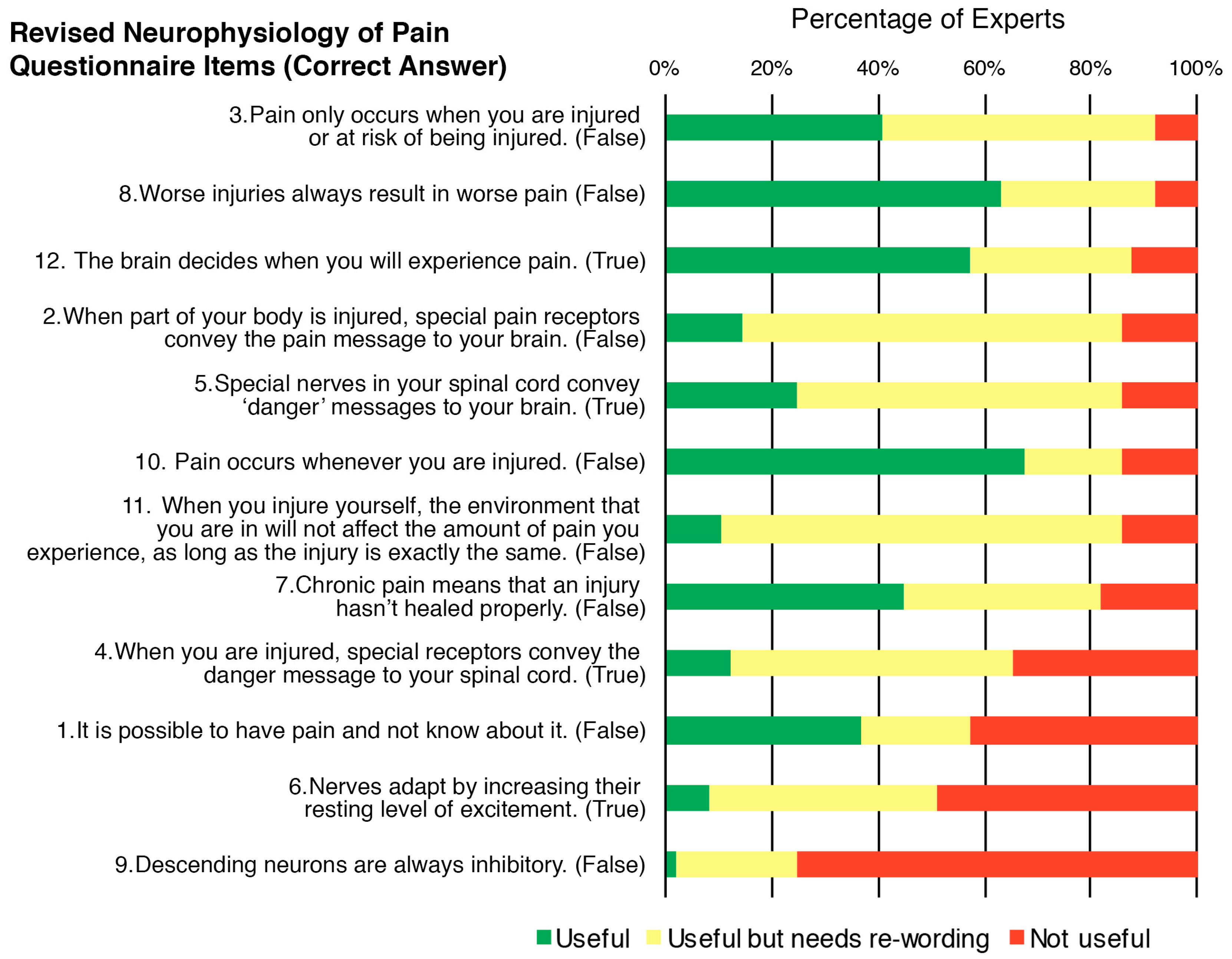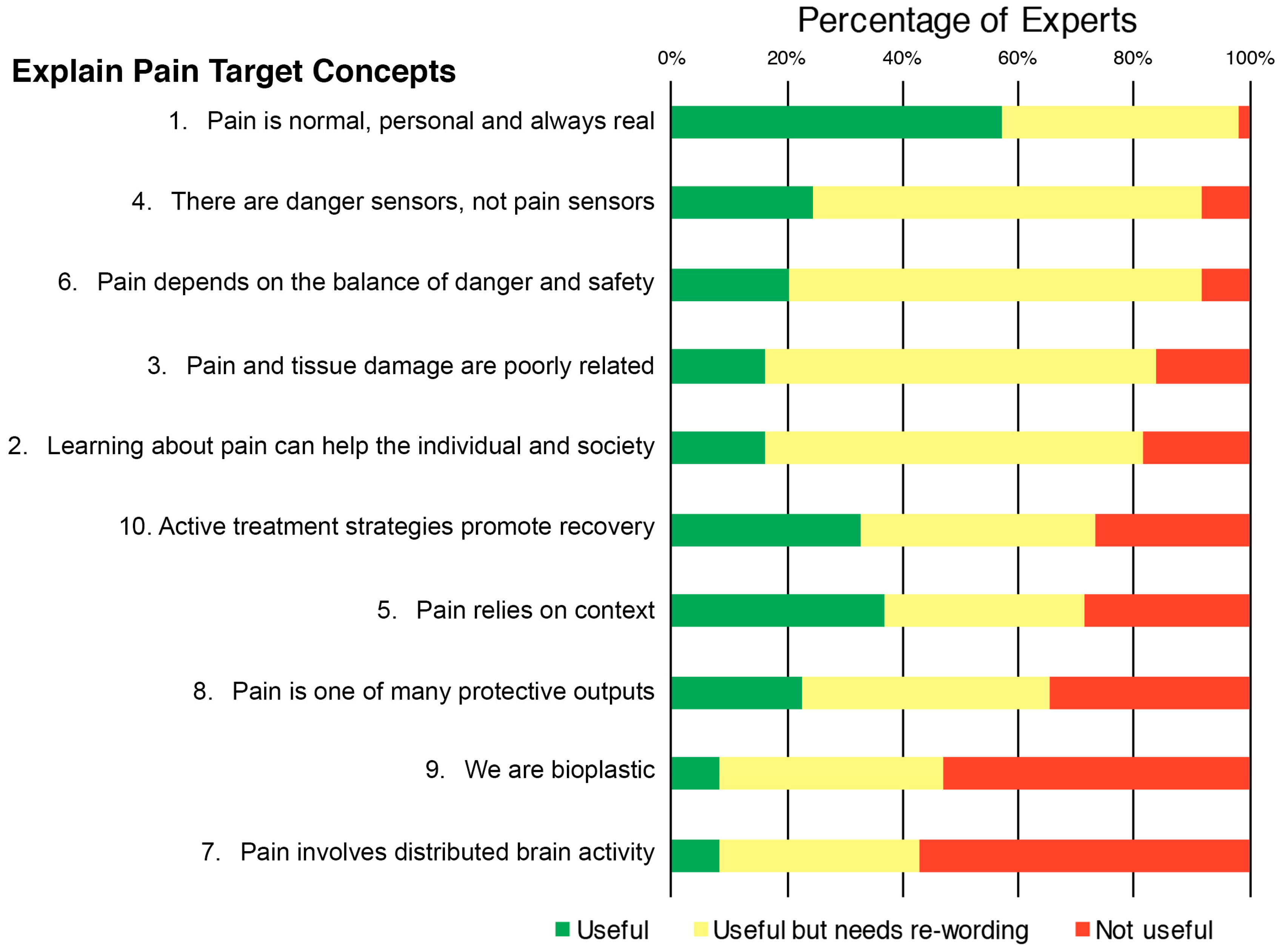A Child’s Concept of Pain: An International Survey of Pediatric Pain Experts
Abstract
:1. Introduction
2. Materials and Methods
2.1. Study Design
2.2. Participants
2.3. Survey Design
2.4. Data Analysis
3. Results
3.1. The Importance and Usefulness of Assessing a Child’s Concept of Pain in Clinical and/or Research Settings (1)
3.2. The Usefulness of the Content of Items within Currently Published Resources for Assessing a Child’s Concept of Pain (2)
3.3. Domains of a Child’s Concept of Pain That Are Important to Assess (3)
4. Discussion
Strengths and Limitations
5. Conclusions
Supplementary Materials
Acknowledgments
Author Contributions
Conflicts of Interest
References
- King, S.; Chambers, C.T.; Huguet, A.; MacNevin, R.C.; McGrath, P.J.; Parker, L.; MacDonald, A.J. The epidemiology of chronic pain in children and adolescents revisited: A systematic review. Pain 2011, 152, 2729–2738. [Google Scholar] [CrossRef] [PubMed]
- Swain, M.S.; Henschke, N.; Kamper, S.J.; Gobina, I.; Ottová-Jordan, V.; Maher, C.G. An international survey of pain in adolescents. BMC Public Health 2014, 14, 447. [Google Scholar] [CrossRef] [PubMed]
- Coffelt, T.A.; Bauer, B.D.; Carroll, A.E. Inpatient characteristics of the child admitted with chronic pain. Pediatrics 2013, 132, e422–e429. [Google Scholar] [CrossRef] [PubMed]
- Odell, S.; Logan, D.E. Pediatric pain management: The multidisciplinary approach. J. Pain Res. 2013, 6, 785. [Google Scholar] [CrossRef] [PubMed] [Green Version]
- Hassett, A.L.; Hilliard, P.E.; Goesling, J.; Clauw, D.J.; Harte, S.E.; Brummett, C.M. Reports of chronic pain in childhood and adolescence among patients at a tertiary care pain clinic. J. Pain 2013, 14, 1390–1397. [Google Scholar] [CrossRef] [PubMed]
- Hunfeld, J.A.; Perquin, C.W.; Duivenvoorden, H.J.; Hazebroek-Kampschreur, A.A.; Passchier, J.; van Suijlekom-Smit, L.W.; van der Wouden, J.C. Chronic pain and its impact on quality of life in adolescents and their families. J. Pediatr. Psychol. 2001, 26, 145–153. [Google Scholar] [CrossRef] [PubMed]
- Lisman-van Leeuwen, Y.; Spee, L.A.; Benninga, M.A.; Bierma-Zeinstra, S.M.; Berger, M.Y. Prognosis of abdominal pain in children in primary care—A prospective cohort study. Ann. Fam. Med. 2013, 11, 238–244. [Google Scholar] [CrossRef] [PubMed]
- Kosola, S.; Mundy, L.K.; Sawyer, S.M.; Canterford, L.; van der Windt, D.A.; Dunn, K.M.; Patton, G.C. Pain and learning in primary school: A population-based study. Pain 2017, 158, 1825–1830. [Google Scholar] [CrossRef] [PubMed]
- Zernikow, B.; Wager, J.; Hechler, T.; Hasan, C.; Rohr, U.; Dobe, M.; Meyer, A.; Hübner-Möhler, B.; Wamsler, C.; Blankenburg, M. Characteristics of highly impaired children with severe chronic pain: A 5-year retrospective study on 2249 pediatric pain patients. BMC Pediatr. 2012, 12, 54. [Google Scholar] [CrossRef] [PubMed]
- Groenewald, C.B.; Essner, B.S.; Wright, D.; Fesinmeyer, M.D.; Palermo, T.M. The economic costs of chronic pain among a cohort of treatment-seeking adolescents in the United States. J. Pain 2014, 15, 925–933. [Google Scholar] [CrossRef] [PubMed]
- Moseley, G.L.; Butler, D.S. Fifteen years of explaining pain: The past, present, and future. J. Pain 2015, 16, 807–813. [Google Scholar] [CrossRef] [PubMed]
- Engel, G.L. The need for a new medical model: A challenge for biomedicine. Holist. Med. 1989, 4, 37–53. [Google Scholar] [CrossRef]
- Posner, G.J.; Strike, K.A.; Hewson, P.W.; Gertzog, W.A. Accommodation of a scientific conception: Toward a theory of conceptual change. Sci. Educ. 1982, 66, 211–227. [Google Scholar] [CrossRef]
- Turk, D.C.; Gatchel, R.J. Psychological Approaches to Pain Management: A Practitioner’s Handbook, 2nd ed.; The Guilford Press: New York, NY, USA, 2002; 590 p. [Google Scholar]
- Fillingim, R.B. Individual differences in pain: Understanding the mosaic that makes pain personal. Pain 2017, 158, S11–S18. [Google Scholar] [CrossRef] [PubMed]
- Gaffney, A.; Dunne, E.A. Developmental aspects of children’s definitions of pain. Pain 1986, 26, 105–117. [Google Scholar] [CrossRef]
- Catley, M.J.; O’Connell, N.E.; Moseley, G.L. How good is the neurophysiology of pain questionnaire? A rasch analysis of psychometric properties. J. Pain 2013, 14, 818–827. [Google Scholar] [CrossRef] [PubMed]
- Louw, A.; Diener, I.; Butler, D.S.; Puentedura, E.J. The effect of neuroscience education on pain, disability, anxiety, and stress in chronic musculoskeletal pain. Arch. Phys. Med. Rehabil. 2011, 92, 2041–2056. [Google Scholar] [CrossRef] [PubMed]
- Louw, A.; Diener, I.; Landers, M.R.; Puentedura, E.J. Preoperative pain neuroscience education for lumbar radiculopathy: A multicenter randomized controlled trial with 1-year follow-up. Spine 2014, 39, 1449–1457. [Google Scholar] [CrossRef] [PubMed]
- Moseley, G.L.; Nicholas, M.K.; Hodges, P.W. A randomized controlled trial of intensive neurophysiology education in chronic low back pain. Clin. J. Pain 2004, 20, 324–330. [Google Scholar] [CrossRef] [PubMed]
- Puentedura, E.J.; Flynn, T. Combining manual therapy with pain neuroscience education in the treatment of chronic low back pain: A narrative review of the literature. Physiother. Theory Pract. 2016, 32, 408–414. [Google Scholar] [CrossRef] [PubMed]
- Van Ittersum, M.W.; van Wilgen, C.P.; van der Schans, C.P.; Lambrecht, L.; Groothoff, J.W.; Nijs, J. Written pain neuroscience education in fibromyalgia: A multicenter randomized controlled trial. Pain Pract. 2014, 14, 689–700. [Google Scholar] [CrossRef] [PubMed]
- Van Oosterwijck, J.; Meeus, M.; Paul, L.; De Schryver, M.; Pascal, A.; Lambrecht, L.; Nijs, J. Pain physiology education improves health status and endogenous pain inhibition in fibromyalgia: A double-blind randomized controlled trial. Clin J. Pain 2013, 29, 873–882. [Google Scholar] [CrossRef] [PubMed]
- Van Oosterwijck, J.; Nijs, J.; Meeus, M.; Truijen, S.; Craps, J.; Van den Keybus, N.; Paul, L. Pain neurophysiology education improves cognitions, pain thresholds, and movement performance in people with chronic whiplash: A pilot study. J. Rehabil. Res. Dev. 2011, 48, 43–58. [Google Scholar] [CrossRef] [PubMed]
- Wijma, A.J.; van Wilgen, C.P.; Meeus, M.; Nijs, J. Clinical biopsychosocial physiotherapy assessment of patients with chronic pain: The first step in pain neuroscience education. Physiother. Theory Pract. 2016, 32, 368–384. [Google Scholar] [CrossRef] [PubMed]
- Meeus, M.; Nijs, J.; Van Oosterwijck, J.; Van Alsenoy, V.; Truijen, S. Pain physiology education improves pain beliefs in patients with chronic fatigue syndrome compared with pacing and self-management education: A double-blind randomized controlled trial. Arch. Phys. Med. Rehabil. 2010, 91, 1153–1159. [Google Scholar] [CrossRef] [PubMed]
- Nijs, J.; Paul van Wilgen, C.; Van Oosterwijck, J.; van Ittersum, M.; Meeus, M. How to explain central sensitization to patients with ‘unexplained’ chronic musculoskeletal pain: Practice guidelines. Man. Ther. 2011, 16, 413–418. [Google Scholar] [CrossRef] [PubMed]
- Traeger, A.C.; Moseley, G.L.; Hubscher, M.; Lee, H.; Skinner, I.W.; Nicholas, M.K.; Henschke, N.; Refshauge, K.M.; Blyth, F.M.; Main, C.J.; et al. Pain education to prevent chronic low back pain: A study protocol for a randomised controlled trial. BMJ Open 2014, 4, e005505. [Google Scholar] [CrossRef] [PubMed]
- Moseley, L. Unraveling the barriers to reconceptualization of the problem in chronic pain: The actual and perceived ability of patients and health professionals to understand the neurophysiology. J. Pain 2003, 4, 184–189. [Google Scholar] [CrossRef]
- Sowell, E.R.; Thompson, P.M.; Leonard, C.M.; Welcome, S.E.; Kan, E.; Toga, A.W. Longitudinal mapping of cortical thickness and brain growth in normal children. J. Neurosci. 2004, 24, 8223–8231. [Google Scholar] [CrossRef] [PubMed]
- Louw, A.; Zimney, K.; Puentedura, E.J.; Diener, I. The efficacy of pain neuroscience education on musculoskeletal pain: A systematic review of the literature. Physiother. Theory. Pract. 2016, 32, 332–355. [Google Scholar] [CrossRef] [PubMed]
- Robins, H.; Perron, V.; Heathcote, L.C.; Simons, L.E. Pain neuroscience education: State of the art and application in pediatrics. Children 2016, 3, 43. [Google Scholar] [CrossRef] [PubMed]
- Lee, H.; Hübscher, M.; Moseley, G.L.; Kamper, S.J.; Traeger, A.C.; Mansell, G.; McAuley, J.H. How does pain lead to disability? A systematic review and meta-analysis of mediation studies in people with back and neck pain. Pain 2015, 156, 988–997. [Google Scholar] [CrossRef] [PubMed]
- Lee, H.; McAuley, J.H.; Hubscher, M.; Kamper, S.J.; Traeger, A.C.; Moseley, G.L. Does changing pain-related knowledge reduce pain and improve function through changes in catastrophizing? Pain 2016, 157, 922–930. [Google Scholar] [CrossRef] [PubMed]
- Sullivan, M.J. Controlling for “confounders” in psychosocial pain research. Pain 2016, 157, 775–776. [Google Scholar] [CrossRef] [PubMed]
- Gedaly-Duff, V. Developmental issues: Preschool and school-age children. In Children in Pain; Springer: Berlin/Heidelberg, Germany, 1991; pp. 195–229. [Google Scholar]
- Arbuckle, R.; Abetz-Webb, L. “Not just little adults”: Qualitative methods to support the development of pediatric patient-reported outcomes. Patient 2013, 6, 143–159. [Google Scholar] [CrossRef] [PubMed]
- Qualtrics. Available online: www.qualtrics.com (accessed on 7 May 2017).
- Moseley, G.L.; Butler, D.S. Explain Pain Supercharged; NOI Group: Adelaide, Australia, 2017. [Google Scholar]
- IBM Corp. IBM SPSS Statistics for Windows; Version 22.0; IBM Corp.: Armonk, NY, USA, 2013. [Google Scholar]
- DeVellis, R.F. Scale Development: Theory and Applications, 4th ed.; SAGE: Los Angeles, CA, USA, 2017; 262p. [Google Scholar]
- Yeung, K.-K.; Engle, L.; Rabel, A.; Adamson, K.; Schwellnus, H.; Evans, C. It just feels weird!: A qualitative study of how children aged 10–18 years describe neuropathic pain. Disabil. Rehabil. 2017, 39, 1695–1702. [Google Scholar] [CrossRef] [PubMed]
- Noel, M.; Palermo, T.M.; Chambers, C.T.; Taddio, A.; Hermann, C. Remembering the pain of childhood: Applying a developmental perspective to the study of pain memories. Pain 2015, 156, 31–34. [Google Scholar] [CrossRef] [PubMed]
- Smail, B.; Kelly, A. Sex differences in science and technology among 11-year-old schoolchildren: II—Affective. Res. Sci. Technol. Educ. 1984, 2, 87–106. [Google Scholar] [CrossRef]
- Christidou, V.; Koulaidis, V.; Christidis, T. Children’s use of metaphors in relation to their mental models: The case of the ozone layer and its depletion. Res. Sci. Educ. 1997, 27, 541–552. [Google Scholar] [CrossRef]
- McGrath, P.J.; Craig, K.D. Developmental and psychological factors in children’s pain. Pediatr. Clin. N. Am. 1989, 36, 823–836. [Google Scholar] [CrossRef]
- Gallagher, L.; McAuley, J.; Moseley, G.L. A randomized-controlled trial of using a book of metaphors to reconceptualize pain and decrease catastrophizing in people with chronic pain. Clin. J. Pain 2013, 29, 20–25. [Google Scholar] [CrossRef] [PubMed]
- Borgers, N.; De Leeuw, E.; Hox, J. Children as respondents in survey research: Cognitive development and response quality 1. Bull. Methodol. Sociol. 2000, 66, 60–75. [Google Scholar] [CrossRef]
- Piolino, P.; Hisland, M.; Ruffeveille, I.; Matuszewski, V.; Jambaqué, I.; Eustache, F. Do school-age children remember or know the personal past? Conscious Cogn. 2007, 16, 84–101. [Google Scholar] [CrossRef] [PubMed]
- Flavell, J.H.; Flavell, E.R.; Green, F.L. Development of children’s understanding of connections between thinking and feeling. Psychol. Sci. 2001, 12, 430–432. [Google Scholar] [CrossRef] [PubMed]
- Piaget, J.; Inhelder, B. The Psychology of the Child; Basic Books: New York, NY, USA, 1969; Volume 5001. [Google Scholar]




| Characteristic | Experts (n = 49) |
|---|---|
| Clinical-only experts: n (%) | 15 (31%) |
| Research-only experts: n (%) | 16 (33%) |
| Clinical/research experts: n (%) | 18 (37%) |
| Professional discipline: n (%) | |
| Psychologist | 27 (55%) |
| Physiotherapist | 8 (16%) |
| Medical | 6 (12%) |
| Nurse | 4 (8%) |
| Occupational Therapist | 4 (8%) |
| Years of experience in pediatric pain: n (%) | |
| 2–5 years | 9 (18%) |
| 6–10 years | 15 (31%) |
| 11+ years | 25 (51%) |
| Number of pediatric pain patients per week by clinicians: n (%) | |
| 0 | 1 (3%) |
| 1–5 | 9 (27%) |
| 6–10 | 14 (42%) |
| 11–20 | 8 (24%) |
| 20+ | 1 (3%) |
| Gender: n (%) | |
| Male | 9 (18%) |
| Female | 40 (82%) |
| Geography: n (%) | |
| USA | 14 (29%) |
| Australia | 13 (26%) |
| Canada | 11 (22%) |
| Belgium | 3 (6%) |
| Denmark | 2 (4%) |
| The Netherlands | 2 (4%) |
| New Zealand | 1 (2%) |
| The Philippines | 1 (2%) |
| England | 1 (2%) |
| Ireland | 1 (2%) |
© 2018 by the authors. Licensee MDPI, Basel, Switzerland. This article is an open access article distributed under the terms and conditions of the Creative Commons Attribution (CC BY) license (http://creativecommons.org/licenses/by/4.0/).
Share and Cite
Pate, J.W.; Hush, J.M.; Hancock, M.J.; Moseley, G.L.; Butler, D.S.; Simons, L.E.; Pacey, V. A Child’s Concept of Pain: An International Survey of Pediatric Pain Experts. Children 2018, 5, 12. https://doi.org/10.3390/children5010012
Pate JW, Hush JM, Hancock MJ, Moseley GL, Butler DS, Simons LE, Pacey V. A Child’s Concept of Pain: An International Survey of Pediatric Pain Experts. Children. 2018; 5(1):12. https://doi.org/10.3390/children5010012
Chicago/Turabian StylePate, Joshua W., Julia M. Hush, Mark J. Hancock, G. Lorimer Moseley, David S. Butler, Laura E. Simons, and Verity Pacey. 2018. "A Child’s Concept of Pain: An International Survey of Pediatric Pain Experts" Children 5, no. 1: 12. https://doi.org/10.3390/children5010012





